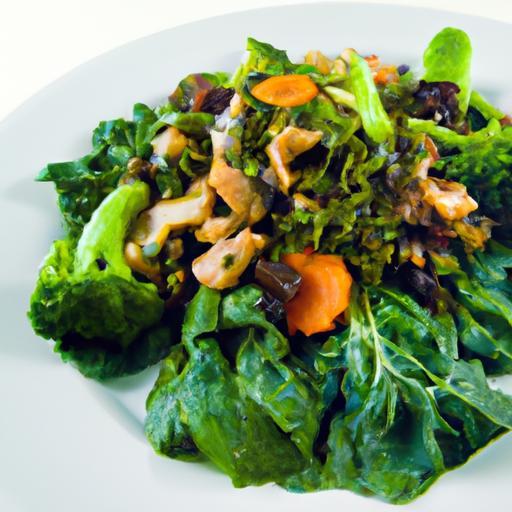In a world where healthful eating meets vibrant creativity, wild greens emerge as the unsung heroes of the culinary landscape. These untamed, nutrient-rich gems offer a thrilling twist to everyday grain bowls, transforming simple dishes into gardens of flavor and texture. From the peppery bite of dandelion leaves to the delicate crunch of chickweed, wild greens invite you to explore nature’s pantry and elevate your meals beyond the ordinary. Join us on a journey where earth’s wildest flavors inspire your grain bowls, turning each bite into a celebration of fresh, wholesome wonder.
Wild Greens Wonders: Elevate Your Grain Bowls Creatively
Wild Greens Wonders bring an extraordinary depth of flavor and nutrition to everyday grain bowls. Foraged from nature’s bounty, these vibrant greens infuse each bite with fresh, herbaceous notes and an array of health benefits, making your meals both delicious and nourishing.
Inspired by years of exploring local habitats and seasonal shifts, I’ve learned that incorporating wild greens into grain bowls multiplies textures and layers flavors beyond ordinary salad leaves. From peppery arugula-like dandelion greens to tender sorrel’s citrus spark, wild greens enhance every grain and topping they meet, bridging earthiness and brightness.
Prep and Cook Time
- Preparation: 15 minutes
- Cooking: 10 minutes (mostly for grains and sautéing)
- Total: 25 minutes
Yield
- Serves 4 generous portions
Difficulty Level
- Medium – ideal for home cooks familiar with grain bowls and open to experimenting with wild ingredients
Ingredients
- 1 cup quinoa, rinsed well
- 2 cups vegetable broth
- 1 cup mixed wild greens (e.g., dandelion greens, sorrel, chickweed, & purslane), washed and roughly chopped
- 1 medium carrot, julienned
- 1/2 cup roasted chickpeas (store-bought or homemade)
- 1/3 cup crumbled feta cheese (optional)
- 1/4 cup toasted sunflower seeds
- 1 small red onion, thinly sliced
- 2 tbsp olive oil
- 1 tbsp apple cider vinegar
- 1 tsp honey or maple syrup
- Salt and freshly ground black pepper, to taste
- Fresh lemon zest for garnish
Instructions
- Cook the quinoa: In a medium saucepan, bring the vegetable broth to a boil. Add the rinsed quinoa, reduce heat to low, cover, and simmer until the liquid is absorbed-about 15 minutes. Fluff with a fork and let cool slightly.
- Prepare the dressing: Whisk together olive oil, apple cider vinegar, honey, salt, and black pepper in a bowl until emulsified. Adjust seasoning to taste.
- Sauté wild greens: Heat a tablespoon of olive oil in a pan over medium heat. Add the wild greens and sauté just until wilted, about 2-3 minutes. Be careful not to overcook-leave a vibrant green color and texture.
- Build the bowl: Divide quinoa between four bowls as the base. Arrange sautéed wild greens, julienned carrots, roasted chickpeas, sliced red onion, and toasted sunflower seeds in attractive sections over the quinoa.
- Add cheese and dressing: Sprinkle crumbled feta over each bowl for creaminess. Drizzle the prepared dressing evenly over all bowls. Toss lightly if desired.
- Final touches: Garnish with fresh lemon zest for a pop of brightness. Serve immediately for best flavor and texture.
Chef’s Notes
- When selecting wild greens, choose tender young leaves for a mild taste. Older leaves can be more bitter but add complexity if balanced with sweet or creamy ingredients.
- For a vegan option, swap feta with sliced avocado or creamy tahini drizzle.
- To prep ahead, cook quinoa and roast chickpeas 2 days in advance. Store greens separately to keep them fresh.
- Use local foraging guides or apps to positively identify wild edible plants to ensure safe harvesting.
- Introduce crunchy nuts like walnuts or pecans as an alternative to sunflower seeds for varied texture.
Serving Suggestions
Layered elegantly in a deep bowl, this dish captivates with colors and textures. Pair with a crisp white wine or chilled herbal iced tea for balanced refreshment. For a heartier variation, top with a poached egg or grilled chicken breast. A garnish of microgreens or edible flowers adds a final touch of artistry.
| Nutrient | Per Serving |
|---|---|
| Calories | 398 kcal |
| Protein | 14 g |
| Carbohydrates | 45 g |
| Fat | 15 g |
Explore trusted foraging resources to deepen your knowledge about edible wild greens safely. For related inspiration, check our Seasonal Grain Bowl Recipes to continue crafting nutrient-packed meals year-round.

Q&A
Q&A: Wild Greens Wonders – Elevate Your Grain Bowls Creatively
Q1: What exactly are “wild greens,” and why should I consider adding them to my grain bowls?
A1: Wild greens are the untamed, nutrient-packed leaves and shoots foraged from nature – think dandelion greens, purslane, nettles, and lamb’s quarters. They bring bold flavors, vibrant textures, and a wealth of vitamins and minerals to your grain bowls, transforming a simple meal into an adventurous delight. Adding wild greens is a way to tap into nature’s pantry, introducing complexity and freshness that standard lettuces simply can’t match.
Q2: How can I safely identify and use wild greens for my meals?
A2: Foraging wild greens requires some knowledge and caution. Start by learning from local foraging guides or joining a workshop with an expert. Always positively identify plants before picking-avoid anything near pollutants or roads. If that’s not your path, many markets and specialty stores offer sustainably harvested wild greens. Once you have them, wash thoroughly and treat them like spinach or kale – sauté, toss fresh, or massage into salads.
Q3: Which wild greens work best in grain bowls, and how do their flavors contribute?
A3: Each wild green has its own personality. Dandelion greens add a pleasant bitterness and chew; purslane brings a tangy, slightly lemony crunch rich in omega-3s; nettles, once cooked, offer a mild, spinach-like flavor; and lamb’s quarters taste subtly peppery and fresh. Mixing these into your bowls alongside grains like quinoa, farro, or millet introduces multifaceted tastes and textures, keeping every bite interesting and healthful.
Q4: What creative pairings and toppings enhance grain bowls featuring wild greens?
A4: Wild greens shine when paired with bold, complementary flavors. Think roasted sweet potatoes for sweetness, toasted nuts or seeds for crunch, creamy avocado for richness, and tangy feta or goat cheese for acidity. Drizzle with bright dressings – citrus vinaigrettes, tahini-lemon blends, or miso-ginger sauces elevate the greens’ natural complexity. Don’t hesitate to add pickled vegetables or a sprinkle of fresh herbs to level up flavor profiles.
Q5: Can wild greens be used in cooked grain bowls, or are they just for fresh bowls?
A5: Wild greens are versatile! While many enjoy them fresh for brightness, they also hold up beautifully when sautéed or gently wilted into warm grain bowls. Cooking mellows their bitterness and softens fibrous stems, integrating them seamlessly with grains and roasted veggies. Try stirring dandelion greens or nettles into a warm bowl of barley and roasted mushrooms for an earth-forward comfort dish.
Q6: How do wild greens benefit your health beyond flavor?
A6: Wild greens are nutritional powerhouses. Many offer impressive doses of antioxidants, vitamins A, C, and K, iron, calcium, and fiber. For example, nettles have anti-inflammatory properties, while purslane is rich in heart-healthy omega-3 fatty acids. Incorporating wild greens can support digestion, boost immunity, and add natural detoxifying compounds – all while making your grain bowls wildly delicious and vibrant.
Embrace the wild side of greens and watch your grain bowls transform from simple meals into lush, creative feasts bursting with flavor, nutrition, and stories of the land.
To Conclude
As you embark on your grain bowl adventures, remember that wild greens are not just ingredients-they’re vibrant bursts of nature’s ingenuity, ready to transform every bite into a celebration of flavor and health. By weaving these untamed wonders into your meals, you elevate simple grains into culinary masterpieces that nourish both body and soul. So next time you craft your bowl, let wild greens lead the way-inviting creativity, freshness, and a touch of wilderness to your plate. Happy foraging, and even happier eating!


